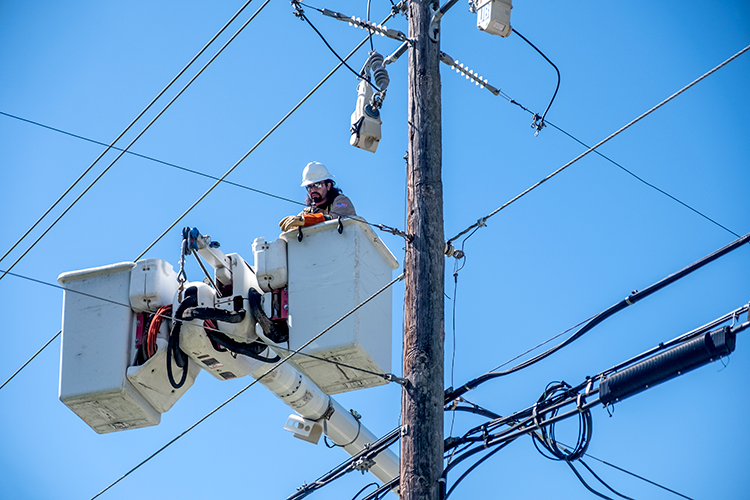
Take it from someone who lived through the September hurricanes that battered our community in 2004, when consecutive Category 2 and 3 storms flooded roadways, ripped off roofs and knocked out power for days and weeks:
The rain and wind you saw last week was nothing.
In fact, we should be counting our blessings, given the damage and devastation Hurricane Ian inflicted on Southwest Florida, where families have been uprooted and a week later the storm’s death toll continues to climb.
We also should be alarmed.
Simply put: There’s no way more than half of Florida Power & Light’s nearly 100,000 customers in Indian River County – homes, businesses and even schools – should lose power in winds recorded at the bottom of the tropical-storm scale.
Not in 2022.
Not with all the new development we’ve seen in recent years, as the county continues to grow.
Not with all the advances made in construction, infrastructure and technology in the 18 years since hurricanes Frances and Jeanne wreaked havoc on our community, and knocked out power for days and weeks.
But that’s what happened as Ian’s outer bands swept through our area, dumping 3.95 inches of rain Wednesday and producing sustained 39-mph winds Thursday.
According to weather officials, we did experience gusts into the 50s – and at least a couple that reached into the 60s – but we never came close to hurricane-force winds, which start at 74 mph.
Yet, more than 50,000 of our neighbors lost power during that two-day stretch, and nearly 1,000 of them were still left in the dark as the sun set Saturday.
That’s more of an inconvenience than a crisis, especially when compared to the tragic losses suffered by the people of storm-ravaged Southwest Florida, where decimated coastal communities could take years to fully recover.
Nobody here should be whining over a couple of days without electricity.
But we should be surprised to see 40-mph winds take down so much of our power grid. As Vero Beach Mayor Robbie Brackett put it: “I didn’t think what hit us was that big a storm.”
It wasn’t.
And that’s what’s so troubling – because if a nothing storm took out half the county, we have no chance of retaining power during hurricanes, which seem to be getting bigger, stronger and more destructive as climate change continues to impact our weather.
So what has FPL been doing since 2004, when Florida was dubbed the “Plywood State” after being smacked by four hurricanes in a six-week span?
“We’ve invested billions of dollars in our grid,” FPL spokesman Peter Robbins said last week. “We’re moving power lines underground, which helps with wind and lightning, and pretty much all new construction has underground wiring. We’re also converting power-line poles from wood to concrete and installing poles closer together to make the lines sturdier.
“All of those things help, but they don’t prevent outages,” he added. “We can be storm resistant.
We can never be stormproof. If a Cat 4 or 5 hurricane hits, people will lose power.”
And when tropical-storm-force winds show up?
Robbins said there’s no specific wind-speed threshold that triggers outages because other factors – including lightning, flooding, and the proximity of trees and vegetation to power lines – enter the equation.
“I can understand people without power being frustrated, even if it’s for only a short amount of time, but hurricanes are very powerful,” he said. “This storm hit the southwest coast of Florida, but we’ve had tens of thousands of outages in South Florida and along the Treasure Coast.”
More than 52,000 of those Ian-related outages occurred in our county, where thousands of new homes have been built since the 2004 hurricanes.
Apparently, though, it was unrealistic to expect that FPL, which serves a hurricane-prone state with nearly 22 million residents, would have spent the past 18 years fortifying its grid to the point where sustained 40-mph winds wouldn’t knock out power in such large numbers.
“It’s unfortunate to have a significant loss of power in the county, but we consider ourselves lucky to not be confronting anything worse,” County Administrator Jason Brown said. “The storm was headed for Orlando, but it made a late turn and came closer to us than we thought it would.
“So if there’s one lesson to be learned from this, it’s that everyone needs to take the threat of tropical systems seriously,” he added. “Hurricane forecasts aren’t always accurate. It doesn’t matter if the storm is on the other side of the state. You need to be cautious and prepare for the worst.”
We can be thankful the worst didn’t come.
Still, we should heed Ian’s warning.
Unless FPL accelerates the hardening of our grid, even a low-level tropical storm will leave most of us powerless.



